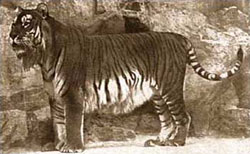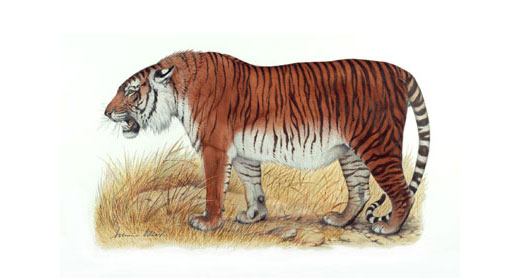Caspian Tiger
The Caspian tiger is also known as the Persian tiger and was known to be a beautiful animal, thought it is thought to have become extinct by the late 1950s. There have been several supposed sightings of the tiger since then, but nothing has been proved, which means that the species is truly extinct or just not available in large enough numbers to be spotted.
The third largest tiger in the world, the Caspian tiger was quite long and stocky and also had unusually large paws compared to other species of tigers. The species had very short ears, furry cheeks, and long hair all over the body surface. The coloring of the Caspian tiger was very much like the Bengal tiger. There is a specimen available for view at the British Museum that shows that the cats were yellowish gold on the back and the flanks with the sides of the body lighter with stripes that varied in color. Male Caspian tigers were very large weighing in at 169-240 kilograms while the females weighed in at a more modest 85-135 kilograms.

Caspian Tiger
The Caspian tiger was known to inhabit Iran, Iraq, Afghanistan, Mongolia, Kazakhstan, Caucasus, Turkey, Tajikistan, Turkmenistan, and Uzbekistan. The species seemed to be able to adapt well to different climates and areas, as long as there were available food sources. While the species was known to be in all of these areas they were solitary animals and only socialized with one another during mating season and the Caspian tiger lived for ten to fifteen years.
It is thought that the Caspian tiger would breed during any time of the year but it was most common in the winter or spring. The mating period of the species lasted 20 to 30 days and if the female did not become pregnant this time she would go into heat again during the same year. When a Caspian Tiger became pregnant she would remain so for about 100 days and then she would give birth to two or three cubs. The cubs were born blind and their eyes did not open for ten days. The tigress was responsible for feeding her cubs for the first eight weeks with her milk and wouldn’t leave the den for at least two weeks, and when they did so it was under the watchful eye of their mother. The cubs would start to hunt on their own by 11 weeks, but up until this point the mother was responsible for feeding herself and the cubs, which was a lot of work because the female raised the cubs on her own. Caspian Tigers gave birth every three to four years.

Caspian tiger (Panthera tigris virgata) drawing
Extinction
The Caspian Tiger became extinct because it was used by the Romans in the arenas and was made to fight against gladiators as well as other animals. The species was also heavily hunted by the Russians who had a plan to clear land and they didn’t feel that there was room for the tiger in their new plans for the land. In other areas the species was hunted because it was known to kill livestock that people were dependent upon. It didn’t take long for the species to disappear altogether being hunted by so many.


intresting and amazing
why would anyone want to hurrt such a marvelous creature
i would never hurt a living thing
how could the romans drive them extinct if the last one killed was in the 40’s 2 thoasand years later
awweee… that is soo sad.. the tiger is one of my MOST favorite animals… I am going to be a Cat Mom. when i get older… I will be working with these kinds of tigers and stuff.. Not exactly these kind but you know.. Anyways….I will be working to be taking care of these animals to protect them and get their numbers up.. I will work to keep these kinds of endagered species from going into extinction…
I felt like crying when I found out how many animals are extinct especially species of tigers. I love tigers so much!!! They are my favorite animals… I also like other animals too such as monkeys,dolphins,etc. i was also born in the year of the tiger. When I grow up I want to do something that helps these animals especially to get their numbers up.
So far I have one cat….. Awsome comment I tottally agree with you. I want to be a vet and have my own shelter for domestic animals, but still love WILD ones to.
this helped me a lot
This is sad! I wish these are not extinct.
this was alot of valuable information
thank you for helping me this helped me study a lot :)
hi
i’m anusha
i’m very happy 2 tel dat this page helped me a lot 4 a project!!!!
thanks :)
this helped me with my assignment
this information helped me so much for my finals!
this is a sad but all too common thing that happens to such beatuful animals. people really suck and this has to stop, im sick of the ignorance. i am so determined to make a difference and help tigers survive. that has been my goal in life since i was five and i refuse to leave this world until ive reached it.
aww what person would hurt such an amazing creature? thats so horible to hurt them i cant belive there extinct.
thanks. the information helped me a lot :)
The caspian tiger rocks and it is so sad it became ectinct.
Thats awlful what they did to those poor creatures , they were doing what they born to do hunt,mate and try to live! : (
Awwww!
I would luv to see a caspian tiger! Why did the romans do that?!They are horrible.Anyway that info really helped me do my research!
they are awesome and i hate people who kill tigers
go to google images and type in endangered animals and you will see a millon tiger skins
What is the cause of its extinction and when did it happen?
Omg Why Would People Put Such Cute Animals To Such a terrifying task….Those People Should Get Set On Fire To See How Painful Death Feels… (: I Feel So Bad For Those Animals there so CUTE ):
wow that is some pretty strong words to be set on fire would be super painful and i do understand that what they did was wrong but that is nothing to put your own kind into so whoever posted that was very wrong to do so shame on you person
you are so not nice to your own kind :-(
You should go to google and type megalodon a species of shark that is extinct.
I think that is very sad that they became extinct because I love animals and study them and didn’t like hearing that but we have to deal with the things that happen you know.
thanks this help me alot
Its summer here and Iam just Looking (bROWSing) on this amazing sight. I love to learn, (Always about animals) and i hate to ever think that people can be so crewl. I wish that it wouldnt happen, but thats live. I LOVE TIGERS
people would be soooo much better if we wernt so greedy or selfish sure it killed livestock but it didn’t know any better I mean if you were starving and your favourate dish was in front of you ,you would take it , so think of Newtons 3rd law, every action has an equil and opposit reaction.
soo sad
how can the people be so cruel to kill such a wonderful animal
Sad D: .. Great website, thanks for the help on my project
All I want to see that Russians are selfish & hope that all of a sudden animals did what they did to the tiger
Thanx a mil… apperciate the help :D
Regret mankind’s urgent requirement to make all into extinction. I must go to India. Eat, Pray, Love.
i like all type of tiger
I hope that tiger populations will be seen to make a comeback
No Caspian tiger are present on zoos?